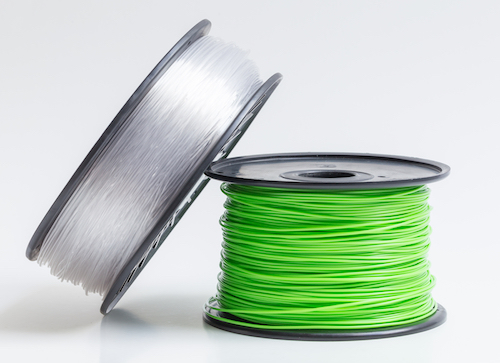Know your 3D Printer Supplies- About 3D Printing Filaments

3D printing filaments are to 3D printers as ink cartridges are to inkjet printers. These filaments are required in order to print a 3D object. Typically bundled in spools, these filaments are available in a variety of materials and colors.
Choosing what filament to use is a lot trickier than selecting an ink cartridge. This guide serves as a starting point to let you determine the right material for your printer and the object you want to create.
The Importance Of Choosing The Right Filament
Different 3D printers have varying specifications. Your printer may not be able to work with certain types of filaments, so be sure to read the manufacturerís description to weed out the materials you cannot use. For starters, determine the filament diameter compatible with your printer. The two standard sizes are 1.75mm and 3mm.
Each filament material comes with its own set of unique characteristics. Some can be incredibly robust, while others may have tremendous flexibility. There are materials that glow in the dark and ones that can conduct electricity. As you might imagine, this entails quite a bit of research before settling on a certain material.
Using the wrong material can cause a print failure. In worse cases, your printer may get damaged. You also donít want to waste your time and resources trying to build something and only end up with a significant mess.
The Top 3D Printing Filaments
There are a wide range of filament materials to choose from with more getting introduced each year. The following are some of the most popular 3D filaments on the market today, including support filaments that may come in handy for your printing projects.
Acrylonitrile Butadiene Styrene (ABS)
Without a doubt, ABS is one of the most used filament materials today. It has a vast array of applications across different industries thanks to its strength and durability. The downside to using ABS is that it can be a pain to work with. This material requires a higher melting point than other filaments. A heated build platform is necessary to avoid uneven shrinkage and warping. Since it is petroleum based, it can emit fumes during the printing process. For this reason, an enclosed build area is required. Its characteristics can also degrade over time, particularly when exposed to excessive sunlight.
Polylactic Acid (PLA)
Alongside ABS, PLA is one of the most popular filaments on the market. Printing using this material requires a lower temperature, although fumes may still be an issue. What makes PLA popular among many 3D enthusiasts is that it offers an excellent finish quality. It is also more flexible compared to ABS as well, albeit more brittle.
Polyethylene Terephthalate (PET)
PET has surged in popularity recently with many considering it the best alternative to ABS and PLA. In fact, experts say that PET combines the characteristics of these two filament materials, earning the nickname ìworkhorseî filament. It can be printed at temperatures between 220 and 250 C. It offers flexibility with astounding toughness. PET is also shock-resistant, water-resistant and chemical-resistant. Whatís more, its price is nearly identical to that of ABS and PLA. PET is an excellent choice for lightweight items, such as phone cases, wearable technology and mechanical parts.
High Impact Polystyrene (HIPS)
HIPS is a support material primarily used when printing with ABS. You canít print something in the air, so you need a support material to create overlaps. HIPS can be removed from the printed object extremely easily, either by dissolving in Limonene or tearing away manually. This material is a must for creating complicated objects with overhangs, preventing ABS from warping or collapsing during the process of cooling down and solidification.
Polyvinyl Alcohol (PVA)
PVA can be used with PLA on a 3D printer with dual extruders. It works similar to HIPS, providing a support structure to maintain the shape of PLA object during printing. During post-processing, PVA is dissolved in water so that only the model is left. The material is resistant to grease, solvents and oil. It can prove useful for PLA designs with peculiar angles and overhangs.
Finding A Starting Point
With the variety of 3D printing filaments to choose from, it can be difficult to choose which one to use. It is recommended to start with the most widely used filaments and experiment with basic prints. This should help you become familiarized with the unique characteristics of each filament material. Through trial and error, you can figure out what 3D printing filaments work optimally with your printer and best fit your 3D designs.
About the Author:
Stephanie Song is a freelance writer and technophile, who enjoys keeping up with the latest gadgets and technology. You can check out her site, InkTonerStore.com for your quality ink and toner cartridge needs.
Please leave a comment and let us know about your experience and insight is with different 3D printer filaments. What 3D printing filament do you use and why?

I had no idea how important filaments were in 3D printing. I have been really following the technology and have wanted to invest in a printer. It is good to know that you should be getting the right filament to avoid any damages.
I’m glad that your article mentions how using the wrong filament for 3D printing can cause a printing failure. My spouse and I are interested in 3D printing to make toy prototypes. We’ll look into these services to find providers who will be the most beneficial.